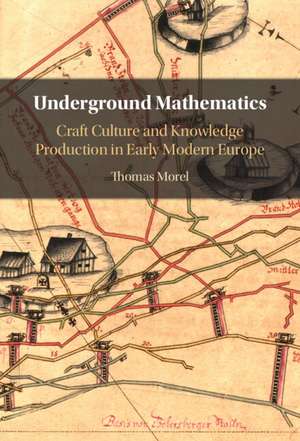Underground Mathematics: Craft Culture and Knowledge Production in Early Modern Europe
Autor Thomas Morelen Limba Engleză Hardback – 21 dec 2022
Preț: 584.57 lei
Preț vechi: 656.82 lei
-11% Nou
Puncte Express: 877
Preț estimativ în valută:
111.86€ • 119.61$ • 93.26£
111.86€ • 119.61$ • 93.26£
Carte tipărită la comandă
Livrare economică 17 aprilie-01 mai
Preluare comenzi: 021 569.72.76
Specificații
ISBN-13: 9781009267304
ISBN-10: 1009267302
Pagini: 258
Dimensiuni: 236 x 160 x 25 mm
Greutate: 0.58 kg
Editura: Cambridge University Press
Colecția Cambridge University Press
Locul publicării:Cambridge, United Kingdom
ISBN-10: 1009267302
Pagini: 258
Dimensiuni: 236 x 160 x 25 mm
Greutate: 0.58 kg
Editura: Cambridge University Press
Colecția Cambridge University Press
Locul publicării:Cambridge, United Kingdom
Cuprins
Introduction; 1. Of scholars and miners; 2. A mathematical culture: the art of setting limits; 3. The mines and the court; 4. Writing it down: innovation, secrecy, and print; 5. 'So fair a subterraneous city': mapping the underground; 6. How to teach it?: finding the right direction; 7. 'One of geometry's nicest applications': crafting the Deep-George tunnel (1771–1799); Conclusion.
Recenzii
'This important book takes recent interest in early-modern practical mathematics into a fresh working setting, the unique challenges of land surveying in mining practice, identifying a robust 'craft of subterranean geometry', in relation to other forms of mathematical and material culture. A sophisticated, authoritative and original analysis.' Jim Bennett, Science Museum, London
'State-organised mining was the first large-scale technological system in early modern Europe. This thoroughly researched book presents fascinating stories about the challenges of underground measurements, the construction of mining maps, and the politics of mining. It provides unprecedented insights into mining surveyors' activities and the art-science of underground geometry.' Ursula Klein, Max Planck Institute for the History of Science
'This is an innovative and thought-provoking book on a rather abstruse topic. Dismissing the geometry of mines as described by humanist scholars, the author delves into the rich and diverse archives of mining offices, and offers a rare glimpse on how a specific mathematical culture developed underground, standardized and circulated.' Jeanne Peiffer, CNRS, Centre Alexandre Koyré, Paris
'State-organised mining was the first large-scale technological system in early modern Europe. This thoroughly researched book presents fascinating stories about the challenges of underground measurements, the construction of mining maps, and the politics of mining. It provides unprecedented insights into mining surveyors' activities and the art-science of underground geometry.' Ursula Klein, Max Planck Institute for the History of Science
'This is an innovative and thought-provoking book on a rather abstruse topic. Dismissing the geometry of mines as described by humanist scholars, the author delves into the rich and diverse archives of mining offices, and offers a rare glimpse on how a specific mathematical culture developed underground, standardized and circulated.' Jeanne Peiffer, CNRS, Centre Alexandre Koyré, Paris
Notă biografică
Descriere
History of the development of practical mathematics in early modern Europe through the practice of mining.
